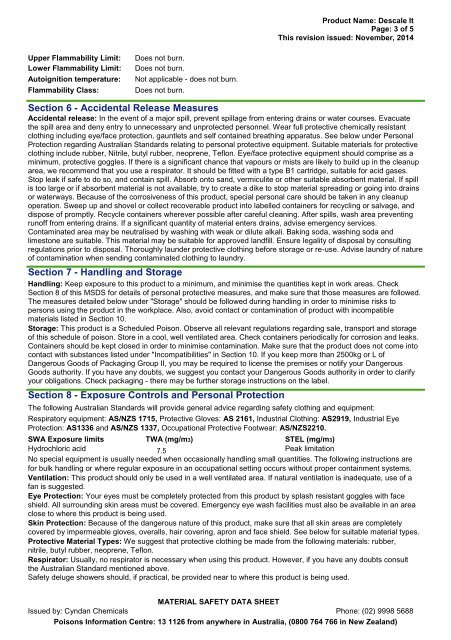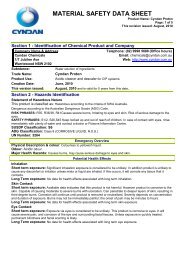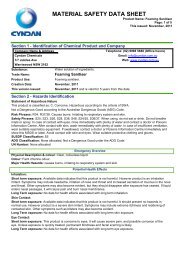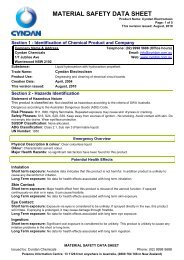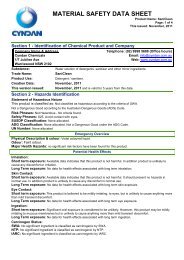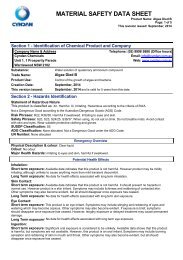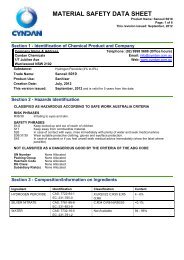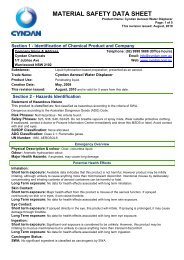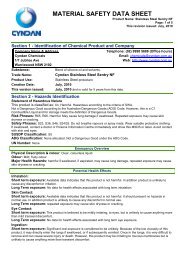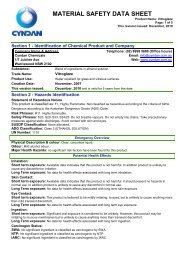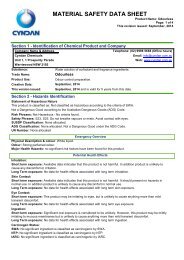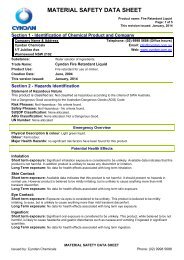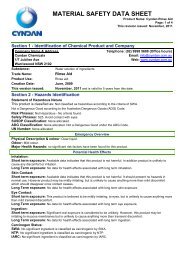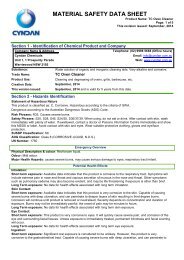Descale It - MSDS - CYNDAN Chemicals
Descale It - MSDS - CYNDAN Chemicals
Descale It - MSDS - CYNDAN Chemicals
You also want an ePaper? Increase the reach of your titles
YUMPU automatically turns print PDFs into web optimized ePapers that Google loves.
Product Name: <strong>Descale</strong> <strong>It</strong><br />
Page: 3 of 5<br />
This revision issued: November, 2014<br />
Upper Flammability Limit:<br />
Lower Flammability Limit:<br />
Autoignition temperature:<br />
Flammability Class:<br />
Does not burn.<br />
Does not burn.<br />
Not applicable - does not burn.<br />
Does not burn.<br />
Section 6 - Accidental Release Measures<br />
Accidental release: In the event of a major spill, prevent spillage from entering drains or water courses. Evacuate<br />
the spill area and deny entry to unnecessary and unprotected personnel. Wear full protective chemically resistant<br />
clothing including eye/face protection, gauntlets and self contained breathing apparatus. See below under Personal<br />
Protection regarding Australian Standards relating to personal protective equipment. Suitable materials for protective<br />
clothing include rubber, Nitrile, butyl rubber, neoprene, Teflon. Eye/face protective equipment should comprise as a<br />
minimum, protective goggles. If there is a significant chance that vapours or mists are likely to build up in the cleanup<br />
area, we recommend that you use a respirator. <strong>It</strong> should be fitted with a type B1 cartridge, suitable for acid gases.<br />
Stop leak if safe to do so, and contain spill. Absorb onto sand, vermiculite or other suitable absorbent material. If spill<br />
is too large or if absorbent material is not available, try to create a dike to stop material spreading or going into drains<br />
or waterways. Because of the corrosiveness of this product, special personal care should be taken in any cleanup<br />
operation. Sweep up and shovel or collect recoverable product into labelled containers for recycling or salvage, and<br />
dispose of promptly. Recycle containers wherever possible after careful cleaning. After spills, wash area preventing<br />
runoff from entering drains. If a significant quantity of material enters drains, advise emergency services.<br />
Contaminated area may be neutralised by washing with weak or dilute alkali. Baking soda, washing soda and<br />
limestone are suitable. This material may be suitable for approved landfill. Ensure legality of disposal by consulting<br />
regulations prior to disposal. Thoroughly launder protective clothing before storage or re-use. Advise laundry of nature<br />
of contamination when sending contaminated clothing to laundry.<br />
Section 7 - Handling and Storage<br />
Handling: Keep exposure to this product to a minimum, and minimise the quantities kept in work areas. Check<br />
Section 8 of this <strong>MSDS</strong> for details of personal protective measures, and make sure that those measures are followed.<br />
The measures detailed below under "Storage" should be followed during handling in order to minimise risks to<br />
persons using the product in the workplace. Also, avoid contact or contamination of product with incompatible<br />
materials listed in Section 10.<br />
Storage: This product is a Scheduled Poison. Observe all relevant regulations regarding sale, transport and storage<br />
of this schedule of poison. Store in a cool, well ventilated area. Check containers periodically for corrosion and leaks.<br />
Containers should be kept closed in order to minimise contamination. Make sure that the product does not come into<br />
contact with substances listed under "Incompatibilities" in Section 10. If you keep more than 2500kg or L of<br />
Dangerous Goods of Packaging Group II, you may be required to license the premises or notify your Dangerous<br />
Goods authority. If you have any doubts, we suggest you contact your Dangerous Goods authority in order to clarify<br />
your obligations. Check packaging - there may be further storage instructions on the label.<br />
Section 8 - Exposure Controls and Personal Protection<br />
The following Australian Standards will provide general advice regarding safety clothing and equipment:<br />
Respiratory equipment: AS/NZS 1715, Protective Gloves: AS 2161, Industrial Clothing: AS2919, Industrial Eye<br />
Protection: AS1336 and AS/NZS 1337, Occupational Protective Footwear: AS/NZS2210.<br />
SWA Exposure limits<br />
TWA (mg/m3)<br />
STEL (mg/m3)<br />
Hydrochloric acid<br />
7.5<br />
Peak limitation<br />
No special equipment is usually needed when occasionally handling small quantities. The following instructions are<br />
for bulk handling or where regular exposure in an occupational setting occurs without proper containment systems.<br />
Ventilation: This product should only be used in a well ventilated area. If natural ventilation is inadequate, use of a<br />
fan is suggested.<br />
Eye Protection: Your eyes must be completely protected from this product by splash resistant goggles with face<br />
shield. All surrounding skin areas must be covered. Emergency eye wash facilities must also be available in an area<br />
close to where this product is being used.<br />
Skin Protection: Because of the dangerous nature of this product, make sure that all skin areas are completely<br />
covered by impermeable gloves, overalls, hair covering, apron and face shield. See below for suitable material types.<br />
Protective Material Types: We suggest that protective clothing be made from the following materials: rubber,<br />
nitrile, butyl rubber, neoprene, Teflon.<br />
Respirator: Usually, no respirator is necessary when using this product. However, if you have any doubts consult<br />
the Australian Standard mentioned above.<br />
Safety deluge showers should, if practical, be provided near to where this product is being used.<br />
MATERIAL SAFETY DATA SHEET<br />
Issued by: Cyndan <strong>Chemicals</strong> Phone: (02) 9998 5688<br />
Poisons Information Centre: 13 1126 from anywhere in Australia, (0800 764 766 in New Zealand)


